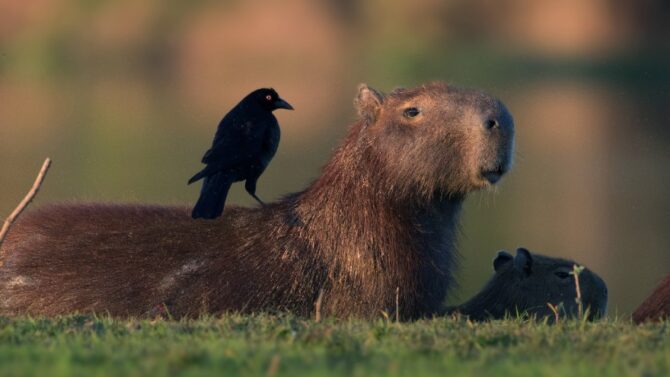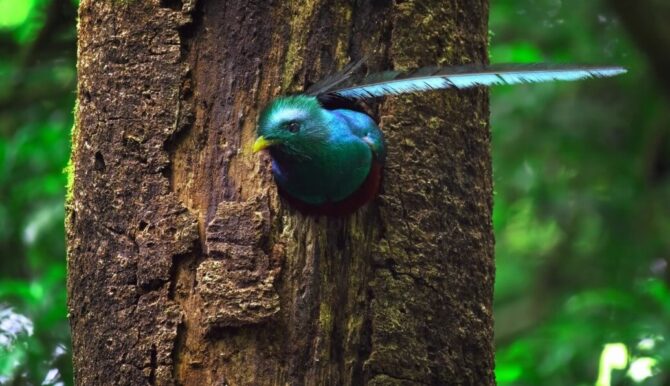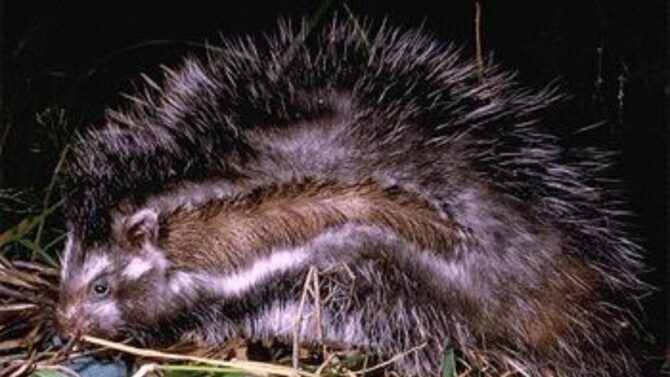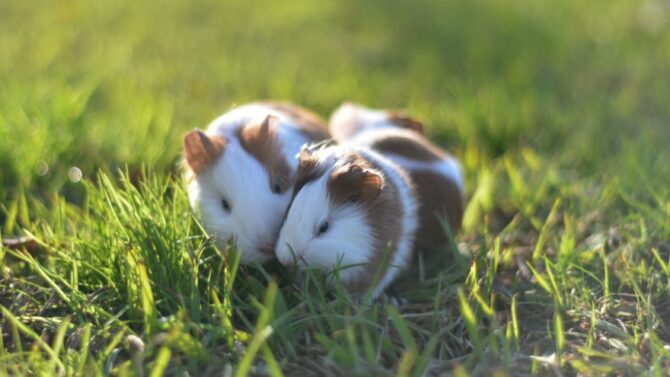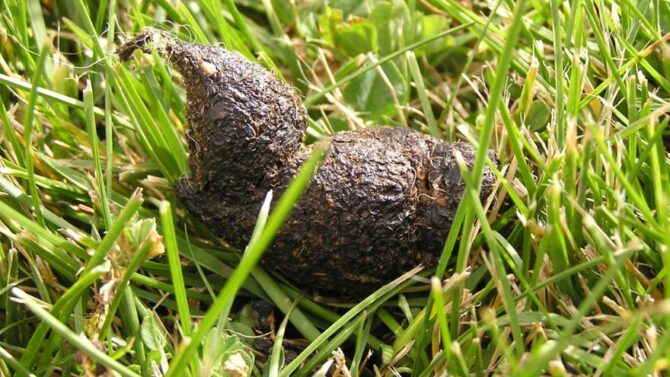People have a limited view of rodents. We either think of them as the cute mouse or hamster pet to admire or the disease-ridden rat to avoid.
However, there’s more to the class of rodents than these two options.
Rodents are more versatile than we think, being the largest mammal group. It’s time to expand our view with a look into some of the biggest types of rodents ever discovered.
The largest rodents in the world include extant species like the muskrat, cape porcupine, capybara, North American beaver, and South African springhare, among others.
Here’s a look into the top 10 world’s biggest rodents—they are definitely not hamsters and mice!
The Largest Rodents in The World
1. Capybara
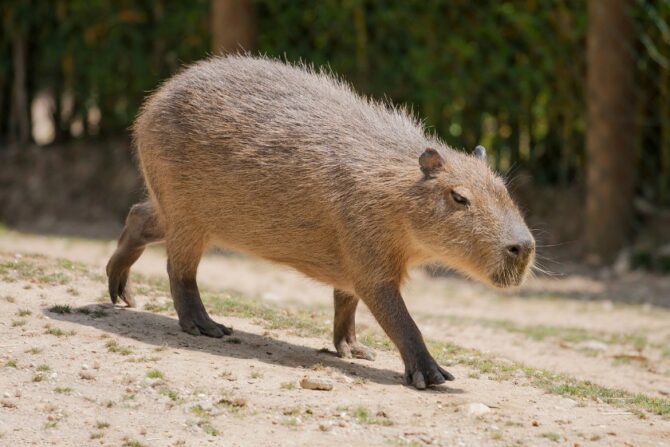
- Scientific Name: Hydrochoerus hydrochaeris
- Length: 3.48 to 4.40 feet
- Weight: 77 to 146 pounds
- Range: South America
- Habitat: Dense forests
- Conservation Status: Least Concern
The first rodent on our list is the capybara, a native of South America.
The capybara is the biggest rodent in the world, weighing over 100 pounds.
This rodent is the size of a Labrador Retriever, which immediately challenges our stereotype of what rodents are like.
Capybaras live in dense forests around water bodies like lakes, ponds, rivers, and swamps.
Being that close to water, it knows how to swim through. It is a herbivore, feeding on fruits and other vegetables. It is also a delicacy for many South Americans.
2. North American Beaver
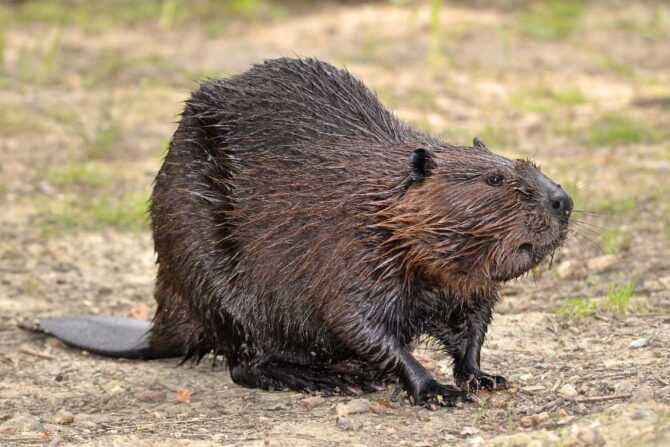
- Scientific Name: Castor Canadensis
- Length: 29 to 35 inches
- Weight: 24 to 71 pounds
- Range: North America
- Habitat: Ponds, lakes, rivers, streams
- Conservation Status: Least Concern
The North American Beaver is a well-known mammal that has all the features of a rodent, the class it is in.
With a height reaching 35 inches and a weight of 71 pounds, the North American beaver is a large one.
It is one of two beaver species, the other being the Eurasian beaver which stays in Europe and Asia.
This creature inhabits areas around water bodies like ponds and lakes. Its tail helps it swim; though strictly speaking, it is not an aquatic animal.
Its most unique ability is the building of dams as a place to live, similar to birds making nests.1
Beavers are territorial, guarding their home against external sources.2
3. Cape Porcupine
- Scientific Name: Hystrix africaeaustralis
- Length: 2.1 to 2.7 feet
- Weight: 37 to 41 pounds
- Range: Africa
- Habitat: Deserts, dense forests
- Conservation Status: Least Concern
The cape porcupine is also called the cape crested porcupine or the South African porcupine.
It is one of the largest porcupines in the world as well as one of the largest rodents found in Africa.
A native of central and southern Africa, it inhabits deserts and dense forests.
This porcupine’s spines are outstanding. Measuring up to 20 inches, the spine is its best weapon of protection.
As herbivores, the cape porcupine has a lot of predators. These spines help it stay alive.
4. Coypu (Nutria)
- Scientific Name: Myocastor coypus
- Length: 2.3 to 3.5 feet
- Weight: 35 to 37 pounds
- Range: South America
- Habitat: Marshes, wetlands
- Conservation Status: Least Concern
The coypu is also known as the nutria, a native of South America, though that’s not the only place it lives.
It has also been introduced in North America, Africa, Europe, and Asia, making it now worldwide.
The coypu looks like a large rat, which might be creepy for every musophobe out there.
Coypus inhabit marshes and wetlands. While it stays more in freshwater marshes, it also lives in brackish and salt marshes, though not as much.
These animals are herbivores, which often brings them into conflict with farmers.
5. Muskrat

- Scientific Name: Ondatra zibethicus
- Length: 16 to 28 inches
- Weight: 1.25 to 4.5 pounds
- Range: North America
- Habitat: Wetlands
- Conservation Status: Least Concern
The muskrat is listed as medium-sized, which translates as “big” amongst rodents.
It is a native of North America but has also been introduced in continents like Asia, Europe, and South America.
It inhabits wetlands, its main habitat. The muskrat is one of the well-known large rodents.
These rodents have family units, joining a male with a female and the young.
As a semi-aquatic animal, it is a good swimmer. It can navigate waters and even swim underwater for 12 to 17 minutes.
Muskrats are more omnivorous than other rodents mentioned so far, feeding on some small.
6. Patagonian Mara
- Scientific Name: Dolichotis patagonum
- Length: 27 to 30 inches
- Weight: 18 to 35 pounds
- Range: Argentina
- Habitat: Open regions
- Conservation Status: Near Threatened
The Patagonian Mara is also known as the Patagonian cavy, the dillaby, or the Patagonian hare.
It is a native of Argentina and Patagonia, with some population occurring in the United Arab Emirates.
It looks like a bigger rabbit, getting up to 30 inches in length.
The Patagonian mara is a herbivore, feeding mainly on fruits and vegetables.
As diurnal rodents, they’re often seen around during the day. Most of their days are spent looking for the next meal.
7. South African Springhare
- Scientific Name: Pedetes capensis
- Length: 31 inches
- Weight: 6 to 7.7 pounds
- Range: Southern Africa
- Habitat: Sandy plains, places with short canvas
- Conservation Status: Least Concern
The South African springhare is a native of South Africa, where it burrows to find a suitable place to live.
The name is a misnomer as the springhare is not a hare. It looks a lot like the kangaroo, albeit a small one. It also hops like one, hence the name “springhare.”
The rodent is a nocturnal animal, coming out to feed at night. During the day, it prefers remaining in its burrows, though there have been occasional sightings.
8. Bosavi Woolly Rat
- Scientific Name: Undescribed
- Length: 32 inches
- Weight: 3.3 pounds
- Range: Papua New Guinea
- Habitat: Jungle
- Conservation Status: Unknown
The Bosavi woolly rat was discovered in 2009 in Papua New Guinea and, since then, has been the subject of many studies.
While it might be part of the genus Mallomys under the Muridae family, this hasn’t been made official. This rat currently has no scientific name.
What we do know is its size and some aspects of its behavior. Being up to 32 inches, the Bosavi woolly rat is a big rodent. Its fur is also thick.
Behavior-wise, the Bosavi woolly rat shows no fear of humans.
9. Giant Hutia
- Scientific Name: Heptaxodontidae
- Weight: 110 to 440 pounds
- Range: West Indies
- Conservation Status: Extinct
The giant hutia, also called the ambyrhiza, were rodents of the family heptaxodontidae who possibly lived in the Caribbean around 100,000 years ago.
It has since gone extinct, with its descendants being very small.
Measurements placed its weight at over 400 pounds, which meant some got as big as a brown bear!3
During its life, it may not have been disturbed by any predators, given its size.
10. Josephoartigasia
- Scientific Name: Josephoartigasia
- Length: 8 ft 7 inches
- Weight: 1,060 to 1,100 pounds
- Range: Uruguay
- Conservation Status: Extinct
The josephoartigasia is a genus of giant rodents named after Jose Artigas, the Uruguayan national hero.
It has gone extinct, but were it alive, it’d have been the biggest rodent. It currently holds the title of the biggest rodent ever discovered.4
It lived during the Early Pliocene down to the Early Pleistocene periods, with there being two species described.
Experts believe climate change might have been responsible for their disappearance.
Final Thoughts
The rodent class goes beyond rats, hamsters, and mice to animals that would not be considered cute pets.
The biggest living rodent is the capybara, but when we consider the extinct rodents, the Josephoartigasia takes the crown of the biggest rodents ever discovered.
References & Notes
- Build a Beaver Dam. U.S. National Park Service.
- Beaver. Forestry and Natural Resources.
- Giant Hutias (Heptaxodontidae). Encyclopedia.com.
- Huge Rodent Was Bigger than a Bull. Live Science.
